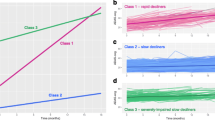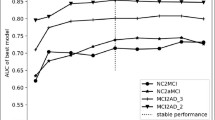Abstract
Background
The diagnostic criteria for Alzheimer’s disease (AD) should be highly sensitive and specific. Clinicians have varying opinions on the different criteria, including the International Working Group-1 (IWG-1), International Working Group-2 (IWG-2), and AT(N) criteria. Few studies had evaluated the performance of these criteria in diagnosing AD and preclinical AD when the gold standard was absent.
Methods
We estimated and compared the performance of these criteria in diagnosing AD using data from 908 subjects in the Alzheimer’s Disease Neuroimaging Initiative (ADNI). Additionally, 622 subjects were selected to evaluate and compare the performance of IWG-2 and AT(N) criteria in diagnosing preclinical AD. A novel approach, Bayesian latent class models with fixed effect dependent, was utilized to estimate the diagnostic accuracy of these criteria in detecting different AD statuses simultaneously.
Results
The sensitivity of the IWG-1, IWG-2, and AT(N) criteria in diagnosing AD was 0.850, 0.836, and 0.665. The specificity of these criteria was 0.788, 0.746, and 0.747. The IWG-1 criteria had the highest Youden Index in detecting AD. When diagnosing preclinical AD, the sensitivity of the IWG-2 and AT(N) criteria was 0.797 and 0.955. The specificity of these criteria was 0.922 and 0.720. The IWG-2 criteria had the highest Youden Index.
Conclusion
IWG-1 was more suitable than the IWG-2 and AT(N) criteria in detecting AD. IWG-2 criteria was more suitable than AT(N) criteria in detecting preclinical AD.



Similar content being viewed by others
Availability of data and materials: The datasets generated during the current study are available in the ADNI repository, http://adni.loni. usc.edu/upload-data/.
Abbreviations
- AD:
-
Alzheimer’s disease
- IWG-1:
-
International Working Group-1
- IWG-2:
-
International Working Group-2
- ADNI:
-
Alzheimer’s Disease Neuroimaging Initiative
- CSF:
-
cerebrospinal fluid
- ADI:
-
Alzheimer’s Disease International
- NINCDS-ADRDA:
-
Neurological Disorders and Speech Disorders and Stroke - Alzheimer’s Disease and Related Disorders Association
- IWG:
-
International Working Group
- NIA-AA:
-
National Institute on Aging and the Alzheimer’s Association
- Aβ:
-
beta-amyloid
- PET:
-
positron emission tomography
- MRI:
-
Magnetic Resonance Imaging
- FDG:
-
fluorodeoxyglucose
- RAVLT:
-
Rey Auditory Verbal Learning Test
- P-tau:
-
phosphorylated tau protein
- T-tau:
-
total tau protein
- SUVR:
-
standardized uptake ratio
- MCMC:
-
Markov chain Monte Carlo
- CI:
-
credible intervals
- PPV:
-
positive predictive value
- NPV:
-
negative predictive value
- MCI:
-
mild cognitive impairment.
References
2021 Alzheimer’s disease facts and figures. Alzheimers Dement 2021;17: https://doi.org/10.1002/alz.12328
Lane CA, Hardy J, Schott JM. Alzheimer’s disease. Eur J Neurol 2018;25: https://doi.org/10.1111/ene.13439
Realdon O, Rossetto F, Nalin M, et al. Technology-enhanced multi-domain at home continuum of care program with respect to usual care for people with cognitive impairment: the Ability-TelerehABILITation study protocol for a randomized controlled trial. BMC Psychiatry 2016;16: https://doi.org/10.1186/s12888-016-1132-y
Dubois B, Hampel H, Feldman HH, et al. Preclinical Alzheimer’s disease: Definition, natural history, and diagnostic criteria. Alzheimers Dement 2016;12: https://doi.org/10.1016/j.jalz.2016.02.002
Beach TG, Monsell SE, Phillips LE, Kukull W. Accuracy of the clinical diagnosis of Alzheimer disease at National Institute on Aging Alzheimer Disease Centers, 2005–2010. J Neuropathol Exp Neurol 2012;71: https://doi.org/10.1097/NEN.0b013e31824b211b
McKhann G, Drachman D, Folstein M, et al. Clinical diagnosis of Alzheimer’s disease: report of the NINCDS-ADRDA Work Group under the auspices of Department of Health and Human Services Task Force on Alzheimer’s Disease. Neurology 1984;34: https://doi.org/10.1212/wnl.34.7.939
Dubois B, Feldman HH, Jacova C, et al. Research criteria for the diagnosis of Alzheimer’s disease: revising the NINCDS–ADRDA criteria. The Lancet Neurology 2007;6: https://doi.org/10.1016/s1474-4422(07)70178-3
Dubois B, Feldman HH, Jacova C, et al. Revising the definition of Alzheimer’s disease: a new lexicon. The Lancet Neurology 2010;9: https://doi.org/10.1016/s1474-4422(10)70223-4
Dubois B, Feldman HH, Jacova C, et al. Advancing research diagnostic criteria for Alzheimer’s disease: the IWG-2 criteria. The Lancet Neurology 2014;13: https://doi.org/10.1016/s1474-4422(14)70090-0
Jack CR, Jr., Bennett DA, Blennow K, et al. NIA-AA Research Framework: Toward a biological definition of Alzheimer’s disease. Alzheimers Dement 2018;14: https://doi.org/10.1016/j.jalz.2018.02.018
Bouwman FH, Verwey NA, Klein M, et al. New research criteria for the diagnosis of Alzheimer’s disease applied in a memory clinic population. Dement Geriatr Cogn Disord 2010;30: https://doi.org/10.1159/000315542
Wang HF, Tan L, Cao L, et al. Application of the IWG-2 Diagnostic Criteria for Alzheimer’s Disease to the ADNI. J Alzheimers Dis 2016;5110.3233/JAD-150824
Kern S, Zetterberg H, Kern J, et al. Burnham SC, Coloma PM, Li QX, et al. Application of the NIA-AA Research Framework: Towards a Biological Definition of Alzheimer’s Disease Using Cerebrospinal Fluid Biomarkers in the AIBL Study. J Prev Alzheimers Dis 2019;6: doi: https://doi.org/10.14283/jpad.2019.25
Adamczuk K, Schaeverbeke J, Vanderstichele HM, et al. Diagnostic value of cerebrospinal fluid Abeta ratios in preclinical Alzheimer’s disease. Alzheimers Res Ther 2015;7: doi: https://doi.org/10.1186/s13195-015-0159-5
Chatterjee P, Pedrini S, Ashton NJ, et al. Diagnostic and prognostic plasma biomarkers for preclinical Alzheimer’s disease. Alzheimers Dement 2022;18: doi: https://doi.org/10.1002/alz.12447
Zhou XH, Obuchowski NA, McClish DK (2011) Statistical Methods in Diagnostic Medicine, John Wiley & Sons, Inc.
Hale C, Last BS, Meier IB, et al. The ModRey: An Episodic Memory Test for Nonclinical and Preclinical Populations. Assessment 2019;26: https://doi.org/10.1177/1073191117723113
Petersen RC, Aisen P, Boeve BF, et al. Mild cognitive impairment due to Alzheimer disease in the community. Annals of neurology 2013;7410.1002/ana.23931
Jack CR, Jr., Knopman DS, Weigand SD, et al. An operational approach to National Institute on Aging-Alzheimer’s Association criteria for preclinical Alzheimer disease. Annals of neurology 2012;71: https://doi.org/10.1002/ana.22628
Fortea J, Vilaplana E, Alcolea D, et al. Cerebrospinal fluid β-amyloid and phospho-tau biomarker interactions affecting brain structure in preclinical Alzheimer disease. Annals of neurology 2014;76: https://doi.org/10.1002/ana.24186
Trojanowski JQ, Vandeerstichele H, Korecka M, et al. Update on the biomarker core of the Alzheimer’s Disease Neuroimaging Initiative subjects. Alzheimers Dement 2010;6: https://doi.org/10.1016/j.jalz.2010.03.008
Shaw LM, Vanderstichele H, Knapik-Czajka M, et al. Cerebrospinal fluid biomarker signature in Alzheimer’s disease neuroimaging initiative subjects. Annals of neurology 2009;65: https://doi.org/10.1002/ana.21610
Prestia A, Caroli A, Wade SK, et al. Prediction of AD dementia by biomarkers following the NIA-AA and IWG diagnostic criteria in MCI patients from three European memory clinics. Alzheimers Dement 2015;11: https://doi.org/10.1016/j.jalz.2014.12.001
Lee J, Jang H, Kang SH, et al. Cerebrospinal Fluid Biomarkers for the Diagnosis and Classification of Alzheimer’s Disease Spectrum. J Korean Med Sci 2020;35: doi: https://doi.org/10.3346/jkms.2020.35.e361
Blennow K, Hampel H, Weiner M, Zetterberg H. Cerebrospinal fluid and plasma biomarkers in Alzheimer disease. Nat Rev Neurol 2010;6: doi: https://doi.org/10.1038/nrneurol.2010.4
Parnetti L, Chipi E, Salvadori N, D’Andrea K, Eusebi P. Prevalence and risk of progression of preclinical Alzheimer’s disease stages: a systematic review and meta-analysis. Alzheimers Res Ther 2019;1110.1186/s13195-018-0459-7
World Alzheimer Report 2018 - The state of the art of dementia research: New frontiers[J]. NEW FRONTIERS
Priest PC, Jennings LC, Duncan AR, Brunton CR, Baker MG. Effectiveness of border screening for detecting influenza in arriving airline travelers. American journal of public health 2015;105: Suppl 410.2105/AJPH.2012.300761r
Jack CR, Jr., Therneau TM, Weigand SD, et al. Prevalence of Biologically vs Clinically Defined Alzheimer Spectrum Entities Using the National Institute on Aging-Alzheimer’s Association Research Framework. JAMA Neurol 201910.1001/jamaneurol.2019.1971
Acknowledgements
Data used in the preparation of this article were obtained from the Alzheimer’s Disease Neuroimaging Initiative (ADNI) database (adni. loni.usc.edu). As such, the investigators within the ADNI contributed to the design and implementation of ADNI and/or provided data but did not participate in the analysis or writing of this report. A complete listing of ADNI investigators can be found at http://adni.loni.usc.edu/wpontent/uploads/how_to_apply/ADNI_Acknowledgement_List.pdf
Funding
Sources of Funding: This work was supported by National Natural Science Foundation of China (Grant No. 81903408), Beijing Excellent Talents Training Founding Project (Grant No. 2018000020124G136), R&D Program of Beijing Municipal Education Commission (Grant KM202011232018), and Key Research and Cultivation Project of Scientific Research on Campus of Beijing Information Science and Technology University (Grant 2021YJPY236). The funder/sponsor had no role in the design and conduct of the study, collection, management, analysis, and interpretation of the data; preparation, review, or approval of the manuscript; and decision to submit the manuscript for publication.
Author information
Authors and Affiliations
Contributions
Authors Contributions: X.N.W.: conceptualization, funding acquisition, methodology, data analysis, writing original draft and review & editing. G.Y.N.: methodology, data analysis, writing-review & editing. J.X.Z.: conceptualization, methodology, and writing—review and editing. H.P.Z.: methodology and writing—review and editing. F.J.L.: methodology, data analysis. J. T.: methodology, data analysis. Z.Y.Z: methodology and writing—review and editing. G.Q.C: writing—review and editing. Y.H.: conceptualization, methodology, project administration, validation, writing—review and editing. Q.G.: conceptualization, methodology, project administration, validation, writing—review and editing. All authors read and approved the final manuscript.
Corresponding author
Ethics declarations
Statements and Declarations: Ethics approval and consent to participate Subjects for this study were obtained from the ADNI. The ADNI was conducted with the approval of the review boards of the respective research institutions, and all subjects signed an informed consent form.
Conflict of interest: The authors declare no that they have competing interests.
Electronic supplementary material
Rights and permissions
About this article
Cite this article
Wang, X., Niu, G., Zhao, J. et al. Evaluating the Performance of Different Criteria in Diagnosing AD and Preclinical AD with the Bayesian Latent Class Model. J Prev Alzheimers Dis (2024). https://doi.org/10.14283/jpad.2024.71
Received:
Accepted:
Published:
DOI: https://doi.org/10.14283/jpad.2024.71




